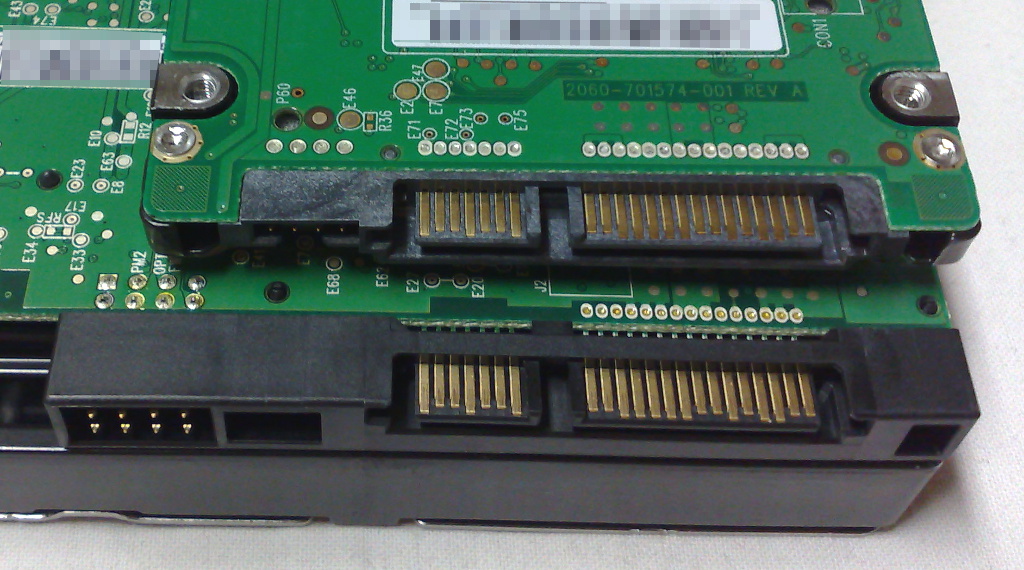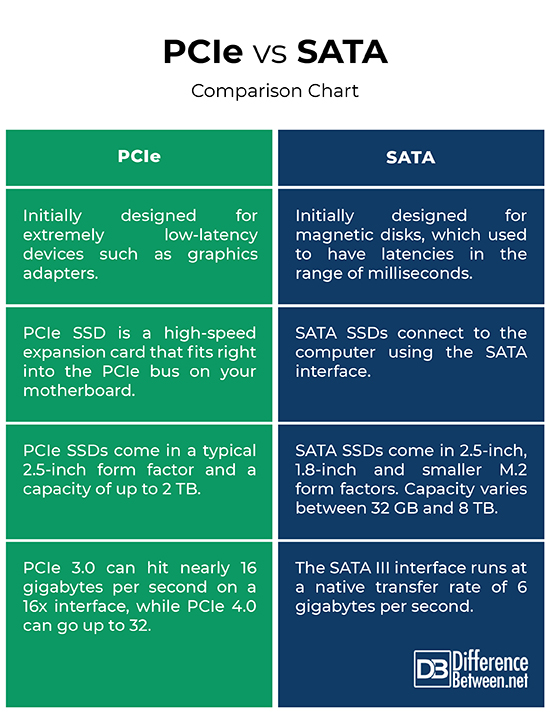Difference Between PCIe and SATA
Solid state drives (SSDs) are all the rage these days and over the years, have gained momentum in enterprise and client applications, replacing the conventional hard disk drives (HDDs). One of the best things about SSDs is that unlike their counterparts, SSDs have no moving parts and they use the same solid state memory technology that is also found in the other forms of flash memory. In a short span of time, SSDs transitioned from a niche item for the tech enthusiasts to a mainstream storage technology used by almost everyone to use the responsiveness of their computer. That being said, Flash SSDs come in two fundamental types: SATA and PCIe. Typically consumer SSDs use a SATA Interface to connect to a computer while a PCIe drive connects directly to the PCI bus.

What is SATA?
Serial ATA, or commonly referred to as SATA, is the most widespread interface for connecting solid state drives. SATA SSDs connect to the host system using the SATA interface employed by most magnetic disks. SATA is basically a widely used interface protocol that connects host bus adapters to mass storage devices such as HDDs and SSDs. SATA has been around for a while, being first appeared on the scene in 2003, and since then, SATA has gotten faster as the drives have become faster. The SATA interface was initially designed for magnetic disks, which used to have latencies in the range of milliseconds. It started with a peak data throughput of 150 Mbps, up from an official parallel ATA ceiling of 133 Mbps, and has since reached a maximum throughput of 600 Mbps, which is a huge jump. Later, SATA-II and SATA-III have gained significant momentum, running at a whopping 6 gigabytes per second and a bandwidth throughput of 600 Mbps.

What is PCIe?
Peripheral Component Interconnect Express, officially abbreviated as PCIe, is a high-speed standard bus interface for connecting motherboard components such as graphics cards, sound cards, Ethernet cards, high-speed WiFi, and SSDs. PCIe is a multifaceted interface developed by the PCI Special Interest Group (also known as the PCI SIG) for extremely low-latency devices such as graphics adapters. It is basically a bus interface used to plug modern expansion cards into modern computers or motherboards. PCIe slots are available in a variety of physical configurations – the most common ones are 1x, 4x, 8x, and 16x. The speed of the PCIe interface is defined by is version and the number of lanes that are grouped together to form a physical connector. The PCIe architecture is based on a dual-simplex embedded clock interface that uses differential signaling on point-to-point connections without the need for physical sideband signal connections.
Difference between PCIe and SATA
Interface
– SSDs come in a variety of form factors and are fundamentally available in two interface connects, PCIe and SATA. Serial ATA, or SATA is the most widely used interface for connecting SSDs which connect to the computer using the SATA interface. The SATA III (third generation SATA) is the most common interface standard for SSDs these days. PCIe, short for Peripheral Component Interconnect Express, is a multifaceted interface developed by the PCI Special Interest Group for connecting motherboard components such as graphics cards, sound cards, Ethernet cards, high-speed WiFi, and SSDs.
Connection
– SATA is a thin, flexible cable with up to 1 meter in length. It is also a point to point connection using a serial physical connection. The serial cable is smaller and easier to route inside the chassis and helps facilitate the designs of smaller PC or handheld systems. It uses ATA and ATAPI command set to drive communications between devices. PCIe slots are available in a variety of physical configurations – the most common ones are 1x, 4x, 8x, and 16x. The speed of the PCIe interface is defined by is version and the number of lanes that are grouped together to form a physical connector.
Form Factor
– SATA solid state drives come in a variety of form factors, 2.5-inch, 1.8-inch as well as smaller M.2 form factors. Typical enterprise grade SATA SSDs use either 2.5-inch or M.2 configuration SSDs. M.2 SATA SSDs are popularly used as boot devices. In terms of capacity, SATA SSDs vary anywhere between 32 GB and 8 TB. PCIe SSDs plus directly into an expansion slot on your motherboard that provides data as well as power connection.
Performance
– The SATA III interface runs at a native transfer rate of 6 gigabytes per second and has a bandwidth throughput of 600 Mbps. SATA started with a peak data throughput of 150 Mbps with the first iteration, up from an official parallel ATA ceiling of 133 Mbps, and has since reached a maximum throughput of 600 Mbps SATA 3.0. PCIe 3.0 can hit nearly 16 gigabytes per second on a 16x interface, which is insane. PCIe 4.0 doubled the bandwidth of its predecessor with a maximum of up to 32 gigabytes per second. PCIe 4.0 is twice as fast as PCIe 3.0 with a 16 GT/s data rate.
PCIe vs. SATA: Comparison Chart

Summary
Typically, consumer SSDs use a SATA Interface to connect to a computer while a PCIe drive connects directly to the PCI bus. SATA SSDs come in a variety of form factors, from a standard 2.5-inch to 1.8-inch drive to smaller M.2 form factor SSDs, whereas PCIe SSDs come in a typical 2.5-inch form factor with a relatively lesser storage capacity. PCIe SSDs have much lower latencies than SATA SSDs, and the newer versions of the PCIe offer up to 16 lanes which account for much faster data transfer rates. Also, PCIe drives are much faster but that depend upon the version of the PCIe that they are designed for.
- Difference Between Caucus and Primary - June 18, 2024
- Difference Between PPO and POS - May 30, 2024
- Difference Between RFID and NFC - May 28, 2024
Search DifferenceBetween.net :
Leave a Response
References :
[0]Farooq, Tariq, et al. Oracle Exadata Expert's Handbook. Massachusetts, United States: Addison-Wesley, 2015. Print
[1]Micheloni, Rino, et al. Inside Solid State Drives (SSDs). Berlin, Germany: Springer, 2018. Print
[2]Hyde, Randall. Write Great Code, Volume 1, 2nd Edition: Understanding the Machine. California, United States: No Starch Press, 2020. Print
[3]Moreira, José and Hubert Werkmann. An Engineer's Guide to Automated Testing of High-speed Interfaces. Massachusetts, United States: Artech House, 2010. Print
[4]Deming, David A. The Essential Guide to Serial ATA and SATA Express. Florida, United States: CRC Press, 2014. Print
[5]Image credit: https://commons.wikimedia.org/wiki/File:2.5-inch_SATA_drive_on_top_of_a_3.5-inch_SATA_drive,_close-up_of_data_and_power_connectors.jpg
[6]Image credit: https://commons.wikimedia.org/wiki/File:Pci_Express_Slot.png
